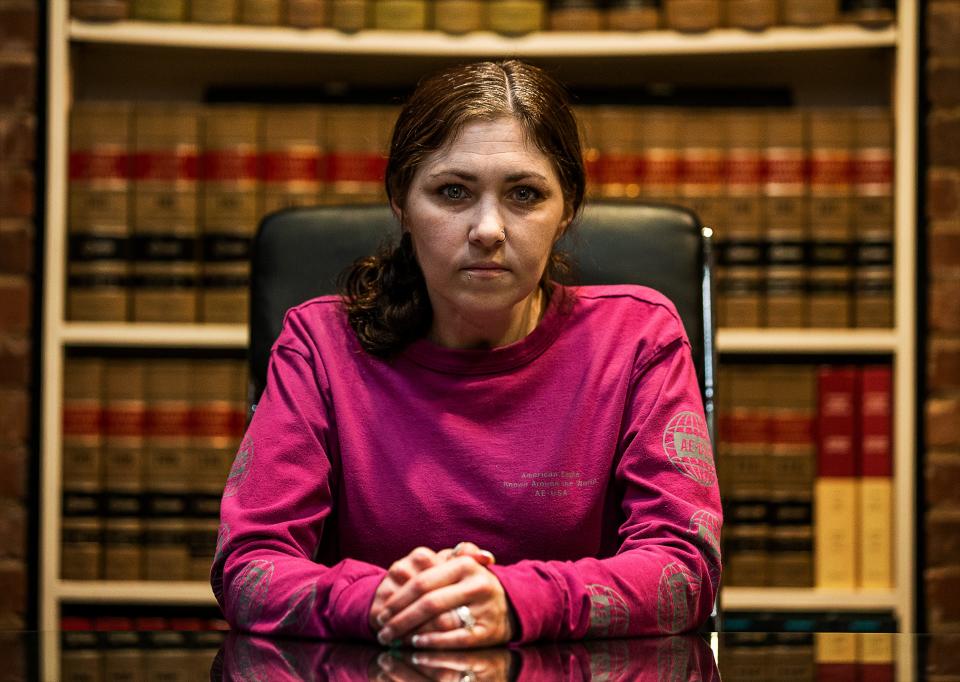Can chiropractic adjustments cause strokes? 2 Kentucky women say yes, and so did a jury
Amber Burgess, then 33, had never set foot in a chiropractor’s office when she went to Dr. Adam Fulkerson’s Heartland Family Chiropractic in Elizabethtown on May 18, 2020.
In contrast, Becca Barlow, 31, had seen Dr. Leah Wright at Louisville Family Chiropractic 29 times for adjustments over three years when she went there on Jan. 7, 2019, seeking relief for "nursing mother’s neck."
Both say they will never see a chiropractor again.
“That visit was my first – and last,” said Burgess, a former utility bucket-truck assembler.
In separate lawsuits, they claim they suffered strokes after their adjustments; Barlow, herself a nurse, said she realized she was having one before she even left the office and told Wright’s staff to call 911.
Citing studies on human cadavers and other research, chiropractors claim adjustments are physically incapable of causing tears to arteries that in turn cause strokes by blocking the flow of blood to the brain and other organs.
In an opening statement in the trial of Barlow’s suit last March, attorney John Floyd Jr., counsel for Wright and the National Chiropractic Mutual Insurance Co., said no one has ever proved adjustments cause the tears – known as dissection – only that there is an “association” between them. “We associate the crowing of roosters with sunrise,” he told the jury. “But that doesn’t mean roosters cause the sun to come up.”
Floyd also cited studies he said prove that when a patient strokes out immediately after adjustments, like Barlow, it is because they already were suffering from artery injuries when they sought treatment from their chiropractor.
A $1 million decision

Louisville attorney Brian Clare, who represents both Barlow and Burgess, previously settled two cases in Jefferson County, and has another suit pending in Warren Circuit Court. He said in an interview that “every time chiropractors perform adjustments on the neck they are playing with fire.''
“They can go too far, too fast, turning the neck past therapeutic limits,” he said.
The jury in Barlow’s case emphatically rejected the chiropractic profession’s defenses.
“We found those claims to be unbelievable, said jury foreman Joseph Tucker, a lawyer, who noted Barlow had no symptoms before her adjustments.
By a 9-3 vote, the jury awarded her $1,030,900, including $380,000 in medical expenses and $750,000 for pain and suffering.
Witnesses testified that Barlow fell off the table and vomited almost immediately after her adjustment, showing classic stroke symptoms, including vertigo, dizziness, numbness and nausea. She lost consciousness, had to be intubated in an ambulance, then raced to Norton Brownsboro Hospital, where she underwent emergency surgery to restore the flow of blood to her arteries and save her life. Three of the four arteries in her had been dissected.
Wright testified that she did the adjustment on Barlow like every other she had performed in her 17 years of practice. But Barlow’s experts said Wright used excessive force in turning her neck and violated the accepted standard of care.
Barlow said she still suffers psychologically from her stroke but is almost completely recovered physically.
Second Kentucky case heading to trial

Burgess, in Elizabethtown, has not been so lucky. She suffered a stroke in her spine that her expert, Dr. Louis Caplan, a neurology professor at Harvard University, said also was caused by her cervical manipulations. Caplan says he's cared for more than 15,000 stroke patients over 45 years.
Fulkerson has denied liability; his lawyer, James Grohman, said he couldn’t comment because the case is pending; trial is set for Aug. 28, 2023, in Hardin Circuit Court
Caplan said in a report that Burgess’s stroke left her with partial but permanent paralysis in her arms and legs. She uses a wheelchair and walker with wheels to get around. Her husband Daniel, her primary caretaker, wheeled her into Clare’s Main Street office for an interview.
Her injuries have turned her life upside down.
She said she can’t work, can’t drive and that while she can dress herself, it takes hours to get ready. She misses motorcycle rides she used to take with her husband and fears they will have to give up their plans to have a baby.
“It is too risky,” she said.
Daniel Burgess said his wife has stayed strong but is embarrassed to be seen in public and sometimes still cries herself to sleep at night.
Conflicting studies
By any measure, strokes associated with adjustments are rare, although their incidence is disputed. The American Chiropractic Association says ays arteries are damaged in only one to three adjustments out of 100,000
But a 2001 report in the New England Journal of Medicine estimated dissections occur in 1 of 20,000 adjustments. And Dr. Alan Brafman, an Atlanta chiropractor, has said they occur more often than that.
Brafman wrote that he's consulted in 1,100 cases, including Barlow's, and found in most of them, chiropractors were at fault, causing vascular damage that is “a tragic, life-altering situation for all parties involved.”
Wright’s experts themselves divulged they had been retained in 200 cases, according to Clare, which he said suggests chiropractic-related strokes are more common than suspected.
A survey at Stanford University in 2008 of 177 neurologists found 55 had patients who suffered strokes after seeing chiropractors, while a 2018 study in West Virginia found one in 48 chiropractors experienced such an event.
Physicians and chiropractors have fought for decades over whether manipulations can cause artery dissections and strokes. The war of words was set off in part by the death of teenager Laurie Jean Mathiason, who suffered a massive stroke on her chiropractor's table in Saskatoon, Canada, and died three days later on Feb. 4, 1998.
Neurologists and other physicians point to a 2001 study in STROKE of 582 stroke patients that found they were five times more likely to have seen a chiropractor in the previous five days before their artery dissection than a control group without such injuries.
But the American Chiropractic Association says neck manipulations are one of the safest and most effective non-drug treatments for common forms of neck pain and headache. Chiropractors point to a study in SPINE, a peer-reviewed journal of 818 dissection patients that found they were more likely to have been treated by a physician than a chiropractor.
Chiropractic experts also say arteries can dissect spontaneously in patients who have pre-existing arterial disease – or even result from everyday activities, such as turning the head while driving or from a vigorous shampooing at a salon. Such patients may then seek treatment from a chiropractor for pain, but their treatment was not the cause of the injury.
The American Heart Association and other medical groups recommend that patients also be warned about the risks; Barlow said she never would have undergone her final manipulation if she had been informed.
The Chiropractic Association says it supports patients giving "informed consent" for procedures but it has no policy recommending or requiring that patients be warned of risks, said spokeswoman Annette Bernat.
Strokes triggered by chiropractic manipulations rarely get press attention. But last July, when Caitlin Jensen, 28, who had just graduated from Georgia Southern University with a master's degree in chemistry and biology, was left paralyzed and in critical condition after a routine visit to a Savannah chiropractor, it produced a flurry of reports, including in Newsweek and People. Local news outlets said she is still recovering at a rehabilitation hospital. The chiropractor has declined to comment, citing privacy laws.
Burgess, the plaintiff recovering from a devastating stroke in Elizabethtown, decided to talk about her trauma for a simple reason: “People need to know about these injuries.”
Chiropractor Q & A
How many people at treated by chiropractors? Thirty-five million Americans see a chiropractor annually.
How many adjustments are performed? America’s 70,000 chiropractors do as many as one million a day
How are adjustments done? Classically done by hand, although sometimes with a small instrument called an activator or a drop table, the chiropractor applies force to realign the spine and restore joint function and reduce pain.
What causes the cracking sound during an adjustment? Manipulations may cause the release of a gas bubble between the joints, which makes a popping sound, such as when you crack your knuckles.
Sources: The Good Body website, American Chiropractic Association
Symptoms of Vertebral Artery Dissection
Trouble with balance or coordination
Dizziness
Hearing loss
Double vision
Neck pain (usually one-sided)
Severe headaches.
Slurred speech
Vertigo
Symptoms of Carotid Artery Dissection
Eye pain
Facial pain
Headache
Sagging eyelid, lack of sweat, and one smaller pupil)
Neck pain
Difficulty speaking, memory problems or loss of balance.
Sources: Cleveland Clinic. Mayo Clinic
This article originally appeared on USA TODAY: Chiropractic visit caused strokes? Jury awards $1 million to KY woman

